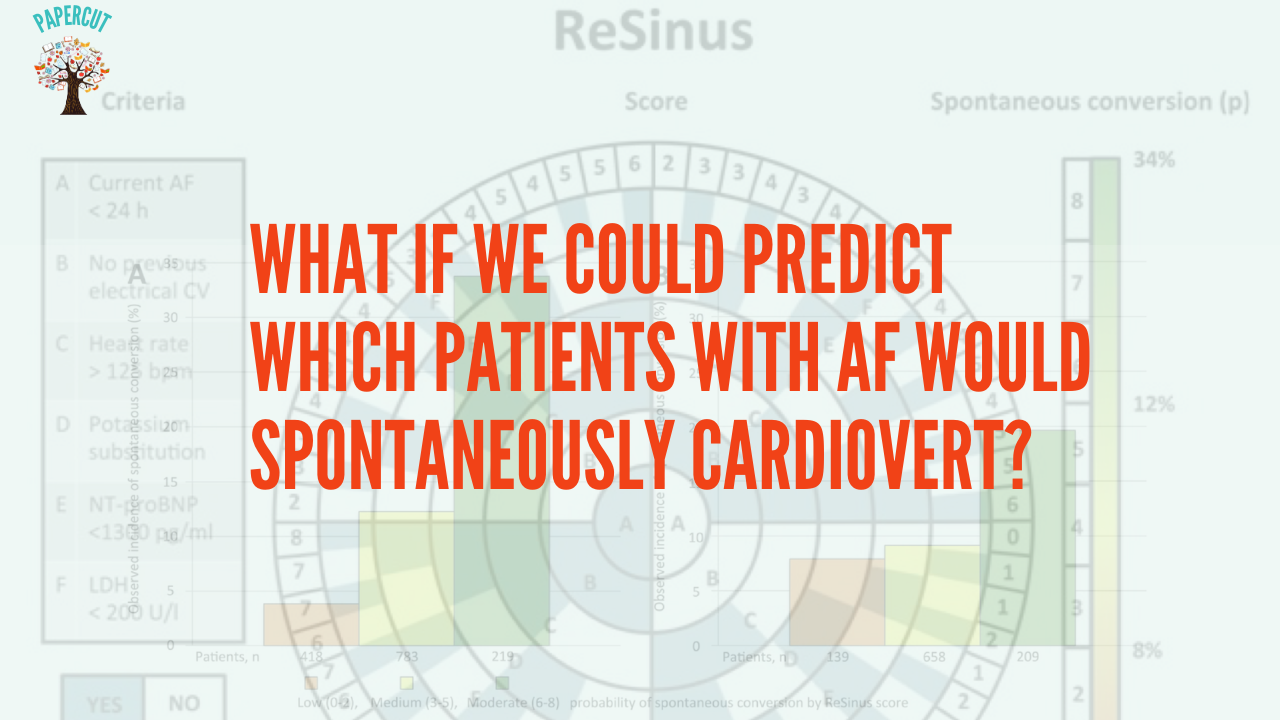What if we could predict which patients with recent onset of atrial fibrillation are more likely to spontaneously cardiovert? It would certainly decrease the number of electrical or medical cardioversions we perform in the emergency department. Sedation and cardioversion, although relatively safe procedures, do have their risks. We know that up to 2/3 of patients spontaneously cardiovert. If we could predict that patient group, we could save a lot of time and resources. It would also be beneficial to those patients with a low chance of cardioversion success, as delaying cardioversion may be harmful.
A CASE: A 61 yo otherwise well patient, presents to the Emergency Department with new rapid Atrial Fibrillation. She felt an onset of palpitations and some dizziness 1 hour before. There is no past medical history. What are the chances that this patient will spontaneously cardiovert? ………enter the ReSinus Score(1)
The ReSinus Score was developed and validated, to estimate the probability of spontaneous cardioversion into sinus rhythm, in adults with haemodynamically stable, non-permanent, symptomatic atrial fibrillation.
What They Did
This was a retrospective cohort study conducted at one emergency department in Vienna. It uses an atrial fibrillation registry.
The score was developed and validated in cases of hemodynamically stable first-detected or recurrent non-permanent symptomatic atrial fibrillation entered into the atrial fibrillation registry between January 2011 and January 2019
Spontaneous conversion was defined as return to sinus rhythm during the Emergency Department visit without any cardioversion. Electrolyte replacement was not considered a cardioversion attempt.
N= 1420 cases in the derivation cohort. 968 patients (67.3%) in the derivation cohort and 717 patients (71.3%) in the validation cohort

The Score
The final weighted score included:
- Duration of AF related symptoms (<24 hours; 2 points)
- The longer the duration of AF, the lower the chance of cardioversion
- Lack of prior cardioversion history (2 points)
- Previous cardioversion may imply structural changes, which may impede cardioversion attempts.
- Heart rate at admission (>125 beats per minute; 1 point)
- A higher heart rate has been associated with a higher chance of cardioversion. A lower heart rate may indicate that the disease is advanced. Remodelling processes in the atria and AVN already progressing.
- Potassium replacement at K+ level ≤3.9mmol/l (1 point)
- NT- proBNP (<1300 pg/ml; 1 point)
- NT-pro BNP has been associated with atrial appendage dysfunction and an increased risk of both new-onset and recurrent AF.
- Lactate Dehydrogenase level (<200 U/l; 1 point)
- It is a non-specific marker of tissue damage. Lactate cascades play a role in atrial remodelling and maintenance of atrial fibrillation.
Observed incidence of short-term spontaneous conversion:
- 50% for patients with 8 points and
- 0% for patients with 0 points

An online Calculator can be used here.
 You can also download the PDF sheet of the paper calculator shown above.
You can also download the PDF sheet of the paper calculator shown above.
Let’s use this technique to look at two patient cases.

My Take on This
- This is a registry-based, retrospective study, so it has all the problems associated with these types of studies.
- We don’t always have all the information we need from registry data.
- It can be difficult to exclude bias.
- A BNP and LDH needs to be done, however given that other labs will need to be ordered, it may not be such a burden.
- It is validated, within the same environment. It needs to be externally validated.
The most important question to ask is: “Will it change my clinical practice?”. My answer is, it might. If I’m working in a large tertiary centre, It won’t affect me much, as I will usually electrically cardiovert. However if I’m in a situation where I have an emergency department, with no resus cubicles to spare (most of the time these days), or it is overnight, or, I am in a resource poor hospital, this might change my practice. If I can better predict who might spontaneously cardiovert, I can send them home, if not overly symptomatic, perhaps on a beta blocker with/without anticoagulation and review them the next day.
I await the validation.
Reference
-
Niederdockl J et al. Predicting Spontaneous Conversion to sinus rhythm in symptomatic atrial fibrillation: The ReSinus score. Eurpo J Int Med. 2021;83:45-53










